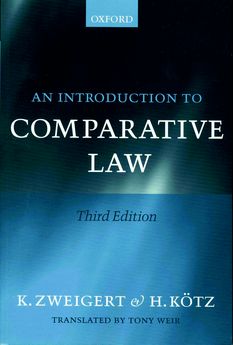This third edition of the modern classic Zweigert & Kötz's Introduction to Comparative Law is fully revised and updated, but its familiar structure and easy style remain the same. The book first discusses the nature of Comparative Law, its functions, aims, methods and history, then it surveys the main features of the major legal families of the world. In the second part it provides a model of comparative law in action, comparing, contrasting and evaluating the different approaches and solutions of the major legal systems. As well as offering an excellent grounding in comparative private law, this book is an essential base for further research. No comparative
lawyer or student of comparative law can operate without it.
Features
- New edition is updated and contains much useful new material, including a chapter on Japanese law
- Contains overview of Comparative law as a subject, its function and methodology
- Outlines all the major legal systems of the world and details individual areas of law within these systems
- It is extremely well written, and skilfully translated from the German by Tony Weir
- The second edition of this volume is highly regarded world-wide and was translated into many languages including Italian, Japanese and Russian
PART I
Abbreviations
Table of Cases
A. GENERAL CONSIDERATIONS
1The Concept of Comparative Law
2The Functions and Aims of Comparative Law
3The Method of Comparative Law
4The History of Comparative Law
B. THE LEGAL FAMILIES OF THE WORLD
5The Style of Legal Families
I. The Romanistic Legal Family
6The History of French Law
7The Spirit and Essential Features of the Code Civil
8The Reception of the Code Civil
9Courts and Lawyers in France and Italy
II. The Germanic Legal Family
10The History of German Law
11The German Civil Code
12The General Civil Code of Austria
13The Swiss Civil Code
III. The Anglo-American Legal Family
14The Development of the English Common Law
15Courts and Lawyers in England
16The Spread of the Common Law Throughout the World
17The Law of the United States of America
18Law-Finding and Procedure in Common Law and Civil Law
IV. The Nordic Legal Family
19Scandinavian Law, Past and Present
V. Law in the Far East
20Chinese Law
21Japanese Law
VI. Religious Legal Systems
22Islamic Law
23Hindu Law
PART II
A. CONTRACT
I. The Formation of Contracts
24Juristic Act, Contract, and General Conditions of Business
25Contractual Capacity
26Offer and Acceptance
27Illegality and Immorality
28Indicia of Seriousness
29The Construction of Contracts
30Mistake, Deceit, and Duress
31Representation
32Assignment
33Contracts for the Benefit of Third Parties
II. The Performance of Contracts
34Claims to Performance and Their Enforcement
35Breach of Contract
36The Effect of Supervening Events
B. UNJUSTIFIED ENRICHMENT
37Unjustified Enrichment in General
38Unjustified Enrichment Specific Topics
C. TORT
39Tort in General
40Liability for others
41Strict Liability
42Invasions of the Right of Personality
Index
Students and scholars of Comparative Law.


